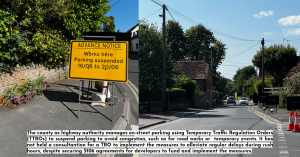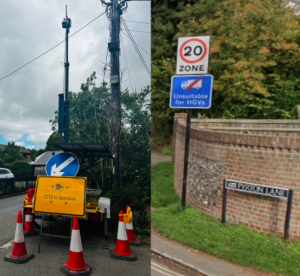Expert studies of traffic in Watlington consistently conclude that on-street parking and HGVs significantly cause delay and congestion.
 On street parking
On street parking
Reports for the county, district, and parish council agree that vehicle queuing at the Couching Street / Brook Street T junction is not caused by the junction itself. The rush hour queuing is largely due to on-street parking on the western side of Couching Street. Vehicles queue back from the on-street parking into the junction and along Brook Street. This causes exit blocking and atypical manoeuvres for local access, and delays (OCC highway officer response, 9th May 2024).
 The county as highway authority manages on-street parking in Watlington using Temporary Traffic Regulation Orders (TTROs) to suspend the parking to avoid congestion, such as for road works or temporary events, but it has refused to implement the measures to alleviate regular delays. A Traffic Regulation Order, if it is not temporary or experimental, requires the highway authority to consult, which it has not carried out, despite receiving £4000 from developers in 2021. Implementing the parking changes would be carried out by developers at no cost to taxpayers.
The county as highway authority manages on-street parking in Watlington using Temporary Traffic Regulation Orders (TTROs) to suspend the parking to avoid congestion, such as for road works or temporary events, but it has refused to implement the measures to alleviate regular delays. A Traffic Regulation Order, if it is not temporary or experimental, requires the highway authority to consult, which it has not carried out, despite receiving £4000 from developers in 2021. Implementing the parking changes would be carried out by developers at no cost to taxpayers.
On-street parking narrows the carriageway to single lanes on Brook Street, Couching Street and Shirburn Street. This creates the conditions for the worst driver behaviour for emissions, according to the government’s Air Quality Expert Group. Source apportionment by air quality consultants to the County Council, Atkins, shows the largest contribution is from diesel cars (48%), followed by diesel vans (29%), HGVs (13%), petrol cars (6%), and buses (4%).
Some temporary parking removal at school and peak hours would significantly reduce emissions, exit blocking for residents and delays, even when taking into account all the planned growth in the district’s housing plan. Making better use of the existing highway also addresses that traffic will still be in Watlington.
HGVs
 National Highways, which manages the nearby M40 motorway, signposts the Watlington Junction 6 as NOT for HGVs, access only. Effective ANPR enforcement to stop HGVs using “unsuitable for HGVs” unclassified roads is used during road works by contractors, but the highway authority has not done the same. Unfortunately, without rigorous enforcement the access only weight limit is being flouted all too often.
National Highways, which manages the nearby M40 motorway, signposts the Watlington Junction 6 as NOT for HGVs, access only. Effective ANPR enforcement to stop HGVs using “unsuitable for HGVs” unclassified roads is used during road works by contractors, but the highway authority has not done the same. Unfortunately, without rigorous enforcement the access only weight limit is being flouted all too often.
The proposed Watlington Relief Road would make the route off Junction 6 easier and quicker at Watlington for HGVs, with roundabouts for turning. Yet the council has no amelioration plan for what happens to communities around Watlington such as Shirburn, Cuxham or Britwell Salome.
Its own study of road freight logistics highlights that HGVs wanting to access the M40 would be drawn by extra road capacity at Watlington to use B roads south of Watlington. Increased use of the county’s rural B roads to access the M40 would harm the Chilterns National Landscape and increase road maintenance, climate and road safety costs.
Making better use of the existing network
Developers have agreed to implement, at their cost, off-site highway improvements and to allow traffic in place of some on-street parking at school hour and peak time. Better enforcement of the 7.5 area weight limit would further improve journeys, without the need to build the road. Oxfordshire County Council’s Local Transport and Connectivity Plan Policy 36a says it will: “Only consider road capacity schemes after all other options have been explored.”
